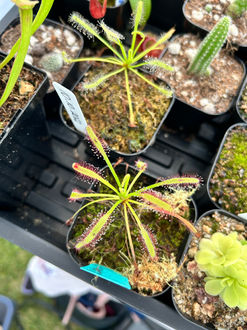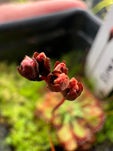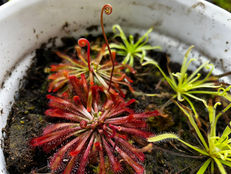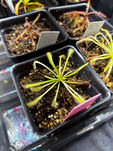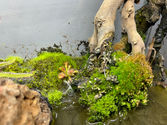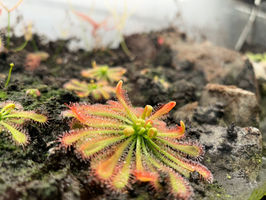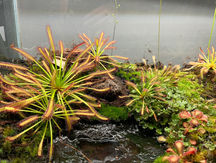Drosera (Sundew) Care

A Drosera capensis traps a housefly
If an insect ever evolved the brains to write a horror novel, the monster in that novel would probably be a sundew.
Sundews are innocent looking and pretty, their delicate leaves sparkling with the promise of sweet nectar, but the foolish insect curious enough to give a sundew the slightest touch will suddenly find itself caught in a living nightmare.
- Peter D'Amato, author of 'The Savage Garden'
Drosera, commonly called 'Sundews', can be easily identified by the clusters of delicate hair-like filaments that grow on the ends of all their leaves and produce a sticky 'dew' - a shared trait amongst all different species within this genus. They can otherwise vary greatly, as they are one of the most diverse genus of carnivorous plants in the world. Some are as tiny as a dime, others as big as 5 feet tall!
Drosera can be found all over the globe, and therefore in all different regions and climates, but do share a preferred environment, much like all carnivorous plants: wet, acidic areas with nutrient-poor soil, also known as 'bogs'.
The Basics
WATER
As bog plants, Drosera thrive when they have 'wet feet' - they want to be sitting in 1-2 inches of water, always. Nutrients and minerals will burn their roots, so filtered is best! We personally use a Brita filter. Avoid top-watering, and mist sparingly, if at all.
LIGHT
Drosera will generally thrive best in very bright, hot locations, but can make do with less if it's unavailable. As a general rule, give them the brightest spot you can - brighter light will allow your Drosera to produce more colour. Grow lights are also great options in dim homes.
SOIL & CONTAINERS
Nutrients and minerals will burn the delicate roots that Drosera have, so their soil should never have any fertilizer or nutrient-rich additives - a plain peat/perlite mix is best for soil. Avoid unglazed ceramic or concrete for the same reason.
FAQ's & Troubleshooting
Do I Feed My Sundew?
You do not need to 'feed' a Drosera! If a Drosera is happy and hungry, it will attract its own food - that is what the dew at the end of their leaves is for. We recommend letting nature do its thing. If you simply must feed your Drosera however, do so sparingly with either a fresh insect no bigger than the width of their leave, or with a small sprinkle of high-protein fish-food.
No Dew on the 'Dew
If your Drosera is not producing dew, there could be a number of reasons. The most common are that its soil is too dry, it does not have enough sunlight, it is too cold (if native to non-tropical areas, cold may put a Drosera into a winter dormancy), or it does not have adequate humidity.
TO FIX: Ensure your plant is in 1-2 inches of filtered water at all times. Try moving your plant to a warmer, sunnier area, or try placing a dome over the plant for a few hours to increase humidity.



